What Are Added Sugars?

When determining the nutritional value of food products, consumers have noticed two types of sugars: added sugar and natural sugar. But what are added sugars and how are they different from natural sugars? Simply knowing the differences between these sugars can help you make eating decisions that will significantly transform your diet, health, and overall wellbeing.
Natural sugar means it is naturally occurring and it is found in fruits, vegetables, and lactose. Sugar found in these consumables, in moderation, should be a part of your daily diet because they come with nutrients that are very good for you. On the other hand, added sugars are sugars that are not naturally occurring but rather conjoined with processed foods. The reason the USDA came up with the name “added sugars” was because they were trying to differentiate them from natural sugar that may be included in other foods with more nutritional benefits. For example, natural sugar in blueberries is concurrently consumed with healthy, natural nutrients such as fiber, potassium, and vitamin C whereas artificial sweetener and cane sugar are not.
Added sugars are most commonly found in sweetened drinks such as soda and fruit punch. They are also in food products such as yogurt, cakes, cookies, and even unexpected foods, such as spaghetti sauce and bread. Added sugars include brown sugar, raw sugar, and white sugar and they are regularly added to processed foods to continue driving product sales. Food manufacturers do this because they understand that consumers as a whole are addicted to sugar and adding sweeteners as preservatives will increase shelf life. As long as manufactures include added sugar in their products, consumers will keep buying them to satisfy their sugar cravings. Left unchanged, many consumers suffer the consequences of a diet rich in added sugars such as childhood obesity, sugar crashes, energy fatigue, nutritional deficiency, hormonal induced acne, sugar addiction, heart disease, and insatiable hunger. To say the least, these health outcomes are not so sweet.
So how do you avoid added sugars and their consequences? First, make sure to check the nutrient labels on food because they will certainly have a category called, “total sugars.” If this amount is high, then the chances are there is added sugar. Normally a teaspoon of sugar is 5 grams, and you want to try to avoid exceeding the recommended 38 grams of sugar per day. Strikingly, in May of 2016, the FDA announced that they are going to revamp the nutritional label in 2018 to help consumers differentiate between natural and added sugars. This is a nice change that will benefit consumers nationwide. In the meantime, the easiest way to reduce added sugars in your diet is to avoid foods that are high in their total sugar.
Another way to avoid added sugars is to eat more natural products, such as fruits and vegetables, and buy from brands that are very transparent about manufacturing fresh food that is not overly processed. Food For Life is a brand that has always strived for nutritional excellence and transparency. Food For Life has the healthiest cereal that contains whole grains or sprouted whole grains, legumes, water, maybe a little natural sugar (malted barley, or agave) and minimal salt for flavor. In the sprouted grain process, there is natural sugar extracted that doesn’t add to the sugar content of the cereal. It is not a simple sugar like high fructose corn syrup that’s artificially added and converts to fat inside the body. This is a healthy cereal that your body will use for fuel in the digestive process rather than store it as fat. The same can be said for Food For Life’s Ezekiel 4:9 Bread. You will not find healthier, more delicious food products that use only natural sugars.
Now that we’ve answered, “What are added sugars?”, find a Store near you that has Food for Life’s healthy products.

